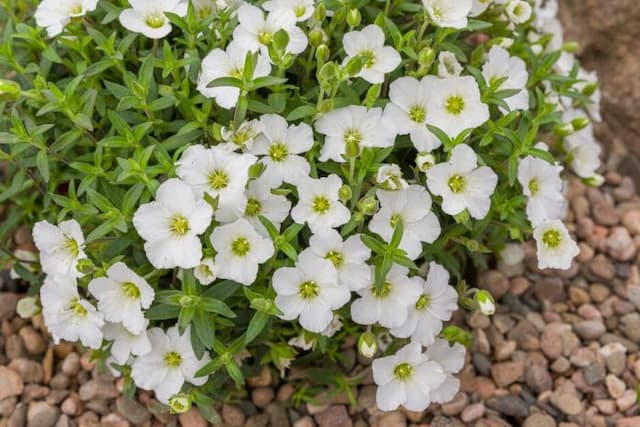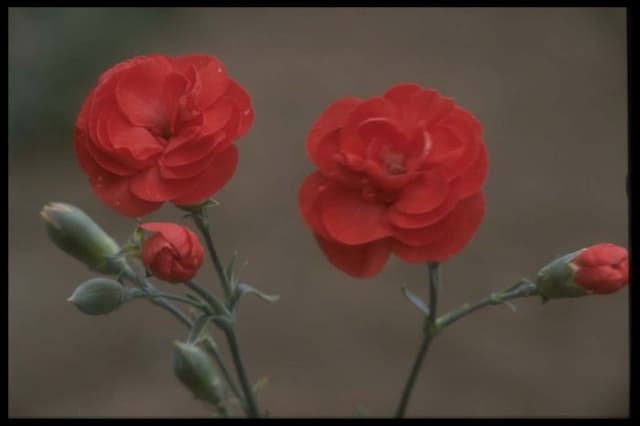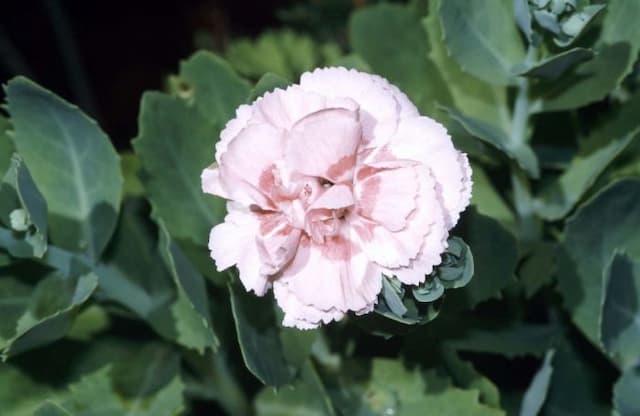Grass rose pink Dianthus pavonius

ABOUT
D. pavonius is a cushion-forming evergreen perennial with green or slightly greyish leaves and 10cm stems bearing 1-3 flowers, 2cm wide, with pale or deep pink petals, buff on reverse
About this plant
 Names
NamesFamily
Caryophyllaceae
Synonyms
Eye of the Peacock, Peacock Pink
Common names
Dianthus pavonius
 Characteristics
CharacteristicsLife cycle
Perennials
Foliage type
Evergreen
Color of leaves
Blue-green
Flower color
Pink
Height
1 foot (30 cm)
Spread
1 foot (30 cm)
Plant type
Herb
Hardiness zones
5
Native area
Europe
Benefits
 General Benefits
General Benefits- Aesthetic Appeal - Dianthus pavonius, commonly known as the Peacock Pink, adds vibrant color to gardens with its lush, fringed flowers in shades of pink, red or white.
- Attracts Pollinators - It attracts bees, butterflies, and other beneficial insects which is crucial for pollination and maintaining a healthy ecosystem.
- Low Maintenance - This plant is relatively easy to care for, requiring minimal water once established and is tolerant of many soil types, though it prefers well-drained, alkaline soil.
- Drought Resistance - Once established, Peacock Pink is relatively drought-tolerant, making it a good choice for gardens in drier climates or water-wise landscapes.
- Perennial Growth - As a perennial, this plant returns year after year, offering long-term presence in a garden without the need for annual replanting.
- Ground Cover - Its dense growth habit makes it an excellent ground cover, helping to reduce weeds and soil erosion.
- Edging Plant - Due to its compact growth, it can be used effectively for borders or edging in garden beds, providing structure and defining garden areas.
 Medical Properties
Medical PropertiesThis plant is not used for medical purposes.
 Air-purifying Qualities
Air-purifying QualitiesThis plant is not specifically known for air purifying qualities.
 Other Uses
Other Uses- Dianthus pavonius, known as Peacock Pink, can be utilized for its natural dye properties, providing a range of pink hues for fabrics and craft materials.
- The fragrant blossoms of the Peacock Pink can be used to make potpourri, offering a natural way to freshen indoor spaces with its pleasant aroma.
- Peacock Pink petals can be pressed and included in decorative bookmarks or paper making for an artistic touch to handmade stationery.
- Edible blooms of Peacock Pink can adorn desserts and salads, adding a colorful and slightly spicy or clove-like flavor to various dishes.
- With its attractive flowers, Peacock Pink can be employed in floral arrangements for weddings and special events as a symbol of love and admiration.
- The plant's foliage and flowers can be used in photography as a natural prop for portraits and macro photography due to its vibrant colors and textures.
- In hobbyist butterfly gardens, Peacock Pink can serve as an ornamental addition, attracting butterflies and other beneficial pollinators to the area.
- Peacock Pink can be part of living jewelry creations, where its blooms are incorporated into wearable art such as necklaces and hairpieces for a unique botanical aesthetic.
- Dried Peacock Pink petals can be used in bath bombs and natural bath soaks for a touch of luxury and visual appeal.
- The Peacock Pink's distinctive appearance can inspire artists and designers, influencing patterns and motifs in fashion and home décor.
Interesting Facts
 Feng Shui
Feng ShuiThe plant_name is not used in Feng Shui practice.
 Zodiac Sign Compitability
Zodiac Sign CompitabilityThe plant_name is not used in astrology practice.
 Plant Symbolism
Plant Symbolism- Passion: Dianthus pavonius, commonly known as Peacock Pink, often symbolizes passion due to its vibrant color that is reminiscent of a peacock's exuberance.
- Admiration: Giving someone Peacock Pinks can indicate admiration, as the flower's distinct appearance is thought to reflect the uniqueness and worth of the person receiving them.
- Pure Love: Dianthus flowers, in general, are associated with pure love and fidelity, meanings that extend to Peacock Pink as well, representing a deep, unwavering bond.
- Boldness: The striking patterns and colors of the Peacock Pink are also seen as a symbol of boldness, encouraging individuals to stand out and be daring in their actions.
 Water
WaterPeacock Pinks should be watered thoroughly when the top inch of soil feels dry to the touch, typically about once a week. You should provide enough water to moisten the soil all the way to the roots, but be careful not to overwater. In terms of quantity, watering with approximately half a gallon per plant every 7-10 days during the growing season is a good rule of thumb. During the cooler months, reduce the frequency as the plant requires less moisture. Ensure the pot has adequate drainage to prevent root rot.
 Light
LightPeacock Pinks thrive best in full sun conditions, which means they should receive at least 6 to 8 hours of direct sunlight daily. The ideal spot for these flowers would be a south-facing garden that gets plenty of light throughout the day. Nevertheless, in extremely hot climates, offering some afternoon shade can help protect the plants from intense heat.
 Temperature
TemperaturePeacock Pinks are best suited to temperatures between 60 and 70 degrees Fahrenheit. They can withstand a minimum temperature of around 40 degrees Fahrenheit and a maximum of about 85 degrees Fahrenheit. Steady temperatures within this range are optimal for healthy growth.
 Pruning
PruningPruning Peacock Pinks is important to encourage bushier growth and more flowers. The best time to prune is after the blooming has finished, usually in late summer or early fall. Deadheading, or removing spent flowers, should be done regularly throughout the blooming season to maintain plant vigor and appearance. You can also trim back the foliage to shape the plant if needed.
 Cleaning
CleaningAs needed
 Soil
SoilPeacock Dianthus thrives best in a well-draining soil mix with a pH range from 6.0 to 7.5. A combination of loam, sand, and compost will create an ideal environment for healthy growth. Ensure the soil mix is porous to prevent waterlogging which can lead to root rot.
 Repotting
RepottingPeacock Dianthus should be repotted every 2-3 years, or when it becomes root-bound. Early spring is the best time to repot this perennial to encourage robust growth throughout the growing season.
 Humidity & Misting
Humidity & MistingPeacock Dianthus prefers moderate humidity levels but is quite adaptable to drier air. It is important to avoid excessively high humidity, as this can foster fungal diseases.
 Suitable locations
Suitable locationsIndoor
Place Peacock Dianthus in a sunny spot, in well-draining soil.
Outdoor
Plant Peacock Dianthus in full sun, ensuring soil is well-drained.
Hardiness zone
5-9 USDA
 Life cycle
Life cycleThe Dianthus pavonius, commonly known as the Peacock Pink, begins its life cycle as a seed which can be sown in late winter to early spring slightly covered with soil and kept moist. Germination occurs over several weeks as the seedlings develop true leaves and a strong root system. Once the seedlings are large enough and the last frost has passed, they are transplanted outdoors to a sunny location with well-drained soil. The Peacock Pink enters a vegetative stage where it grows and matures, forming a mound of slender leaves and stems, until the flowering period in late spring to early summer. The characteristic purple-pink, fragrant flowers bloom, attracting pollinators for seed production. After flowering, as the growing season ends, the plant may either die back if it is an annual variety or become dormant over winter, with the perennial varieties returning the following spring.
 Propogation
PropogationPropogation time
Spring-early summer
The most popular method of propagation for Dianthus pavonius, also known as Peacock Pink, is by seed. For successful growth, seeds should ideally be sown in late winter to early spring under cover to protect them from extreme conditions. A light soil mix or seed starting formula is generally recommended to ensure proper drainage and aeration. Seeds should be scattered lightly on the surface of the moist soil and not covered, as they require light for germination. The environment should be kept at a temperature of around 65 to 70 degrees Fahrenheit (18 to 21 degrees Celsius). Germination typically occurs within two to three weeks. Once the seedlings have developed true leaves and are large enough to handle, they can be transplanted to their final growing location.



![Pink [Tequila Sunrise]](/_next/image?url=https%3A%2F%2Fplants-admin.emdemapps.com%2Fimages%2Fplants%2F%2Fimages%2F604b5d995d06e.png&w=640&q=75)





